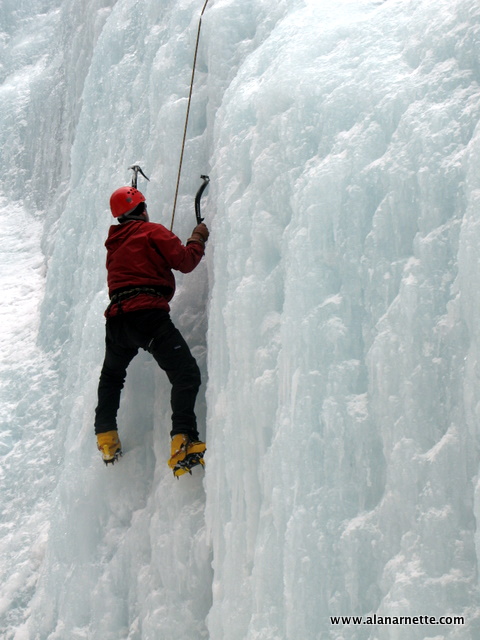The big news is that the route to camp 3 on the Lhotse Face is now in thus preparing the way for climbers to spend the night at the highest camp prior to their summit bid. Many teams on the south have now spent a few nights as high as camp 2 and on the north only a couple have even made it up to the North Col due to harsh weather at the moment.
Over the years, the strategy of acclimatization has not significantly changed. The primary tenet is to climb high and sleep low thus stressing the body to create more red blood cells needed to provide oxygen to the muscles. As regular climbers and followers know this is accomplished through successively higher climbs and nights from base camp to the launching point for the summit bid. The trick is to get the body ready for the stress of high altitude without destroying it in the process.
For this season Altitude Junkies seems to be leading the way. Today they left for camp 2 with the intent to tag camp 3 on the Lhotse face, try the first team to do this. I expect Simone Moro, going for a summit without supplemental oxygen, to be right there with them. With the lines fixed to camp 3, Sherpas will start hauling tents and gear to this difficult spot. They will also begin carrying a few oxygen bottles. Next up is fixing the route to the South Col.
You may notice that some teams are just now moving to camp 1 and others are looking at camp 3. The benefit of going higher earlier is that you can take advantage of the first summit window when it appears because you are acclimatized. The disadvantage is that you may have a couple of weeks of waiting if weather shuts down the routes. In general acclimatization last about a month on Everest so waiting is not a problem except mentally.
Conversely, teams that are waiting to go higher risk having their acclimatization rotations interrupted by weather and in extreme cases, missing the summit window by not being ready. This is more of an issue on the south because the Icefall Doctors stop maintaining the Icefall route on June 1. The benefit of taking it slowly is that climbers adjust slowly and more steadily and can take advantage of tracks from the previous teams.
Another interesting variation in acclimatization is whether to sleep at camp 3 or not prior to the summit push. The Altitude Junkies team is choosing not too while others will. The trade-off is the wear on your body by spending the night at 23,500 without oxygen verses the benefit of acclimatization. In another approach, some climbers will start using supplemental oxygen from camp 2 on, however this is not common.
Acclimatization is highly unique to each individual and can vary from climb to climb. There is no right or wrong and it is good to see the various approaches.
I just love this post from EverestER discussing the social aspect of Everest Base Camp. We can all relate:
Have you ever noticed how you and your friends find yourselves in the kitchen? You’ve cleaned the bathroom, returned from the store, built a fire, prepared a fine meal, a tray of appetizers, guests have arrived, cocktails in hand and there you all are in the kitchen. It can be tiny, it can be high ceiling-ed and grand, the appliances aerospace-inspired or college-days mismatched, it makes no difference.
Here, we do have a dining tent and, however standard fare it is for EBC, it’s really a fine thing: double-walled, of a cheery yellow fabric, plastic flowers of unearthly colors gracing the table and wound round in South Pacific fashion up sturdy supports above our heads, a table row of condiments that’d be the envy of any well provisioned bachelor, (debatably) comfortable lawn chairs and a portable, propane heater that gratefully is lit when the sun signs off behind the south ridge of Pumo Ri.
Yet here we all are in the kitchen, Sherpa, docs, climbers and friends stopping by. The roof is a low lying blue tarp over a steel, tubular frame, held down against the winds by interlocking manila rope anchored to a surrounding short wall of “well ventilated,” dry-stacked stone (duck lowly when you enter) that integrates a seat-high bench that wraps the room. On one end we’re tucked shoulder to shoulder around a central table like an after-dance, late-night diner booth, hands stuffed in down pockets, with voices elevated over the hissing stoves and Nepali pop. Most importantly, we’re all of us warm in an in-it-together familiarity.
Over on the north, Bill Burke once again reports of very high winds and extremely cold temps. SummitClimb reported a climb to the North Col in their full down suits due to the conditions.
While there is a lot of activity, it is still very early. First summits were in late May – a month from now – in some years. So climbers with aliments or just now arriving have no need to worry or rush.
Climb On!
Alan




3 thoughts on “The Strategy of Acclimatization”
I write from Brazil. I am crazy about mountains and specially the Everest. I never climbed a mountain but I know much about them. Now that I found this website, be sure that someone in Brazil is following each of your steps. In 2008 I bought air tickets to cross [by car, of couse] from Lhasa to Katmandu but I could not go because of political problems involving China and Tibet. Disappointing! Regards from Rio de Janeiro. Eduardo
I have spent cold days and nights huddeled around a fire in a breezy cabin.Thats where I start having fun!Brings back good memories of the pains and pleasures of what it takes to go high.
Looking forward to following this blog from here in Haworth, Yorkshire UK.
Comments are closed.